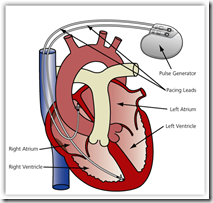With no additional interaction from the patient, the device automatically sends data to the patient’s physician. The first implant was completed in  Canada. Data is normally sent when the patient is sleeping. I have written here quite a bit about the Merlin system from St. Jude as it has developed through FDA approval all the way to integration with HealthVault from Microsoft.
Canada. Data is normally sent when the patient is sleeping. I have written here quite a bit about the Merlin system from St. Jude as it has developed through FDA approval all the way to integration with HealthVault from Microsoft.
St. Jude Medical Announces FDA Approval of New Features with Merlin for Implantable Cardiac Devices
With its open architecture and standards-based interface, Merlin.net PCN is also fully integratable with all standard electronic health record (EHR) systems. In the related reading section below are some links for prior posts about the history of the development of the Merlin system. The Merlin.net Patient Care Network is the gateway used for the physicians to access information. BD
From the website, information for physicians
Direct Connections to Electronic Health Records
- Use Merlin.net PCN to centralize device data from remote follow-ups, in-clinic and post-implant programmer sessions
- Export all patient device data from Merlin.net PCN directly into your EHR
- Connect to the first cardiac rhythm management company to pass EHR standard guidelines set forth by IHE (Integrating the Healthcare Enterprise)
Direct Connections to Your Patients
- Access your patients' device information anytime, anywhere
- Enable patients to transmit from the comfort of their homes or while they are traveling
- Allow transmitters to be placed in remote clinics, nursing homes, and emergency rooms
- Reduce the number of office visits, providing greater convenience and flexibility for your patients
Direct Impact on Your Productivity
- Experience first-hand the Merlin.net PCN easy-to-use interface
- View easy-to-read reports
- Save time by selecting up to 50 patient records at a time to view, print, export and archive

- Archive data stored on Merlin.net PCN for a minimum of seven years
The electrophysiology team at the Montreal Heart Institute (MHI) recently performed the first implantation of a new type of cardiac pacemaker (Accent RF(TM)) in Canada. This landmark procedure was carried out on October 22, 2009 by Drs. Bernard Thibault and Peter Guerra. Both are cardiologists, electrophysiologists at the MHI and professors at the Université de Montréal. The Accent RF(TM) pacemaker uses wireless technology and is intended for people with bradycardia, an abnormally slow heart rate. The patient responded favorably to the procedure, and four additional implantations have since been performed, again with successful outcomes.
A major innovation in telemedicine
Developed by St-Jude Medical, this device provides electronic stimulation when the heart beats too slowly. It also makes it possible to monitor the patient's condition at a distance - a major practical advantage - which ensures more effective communication between the patient and the physician. Indeed, this cardiac pacemaker is the first to offer automatic test results and complete diagnostics that can be accessed via wireless communication from the physician's office or the patient's home. This device has been approved by Health Canada.
Montreal Heart Institute performs landmark procedure
Related Reading:



0 comments :
Post a Comment